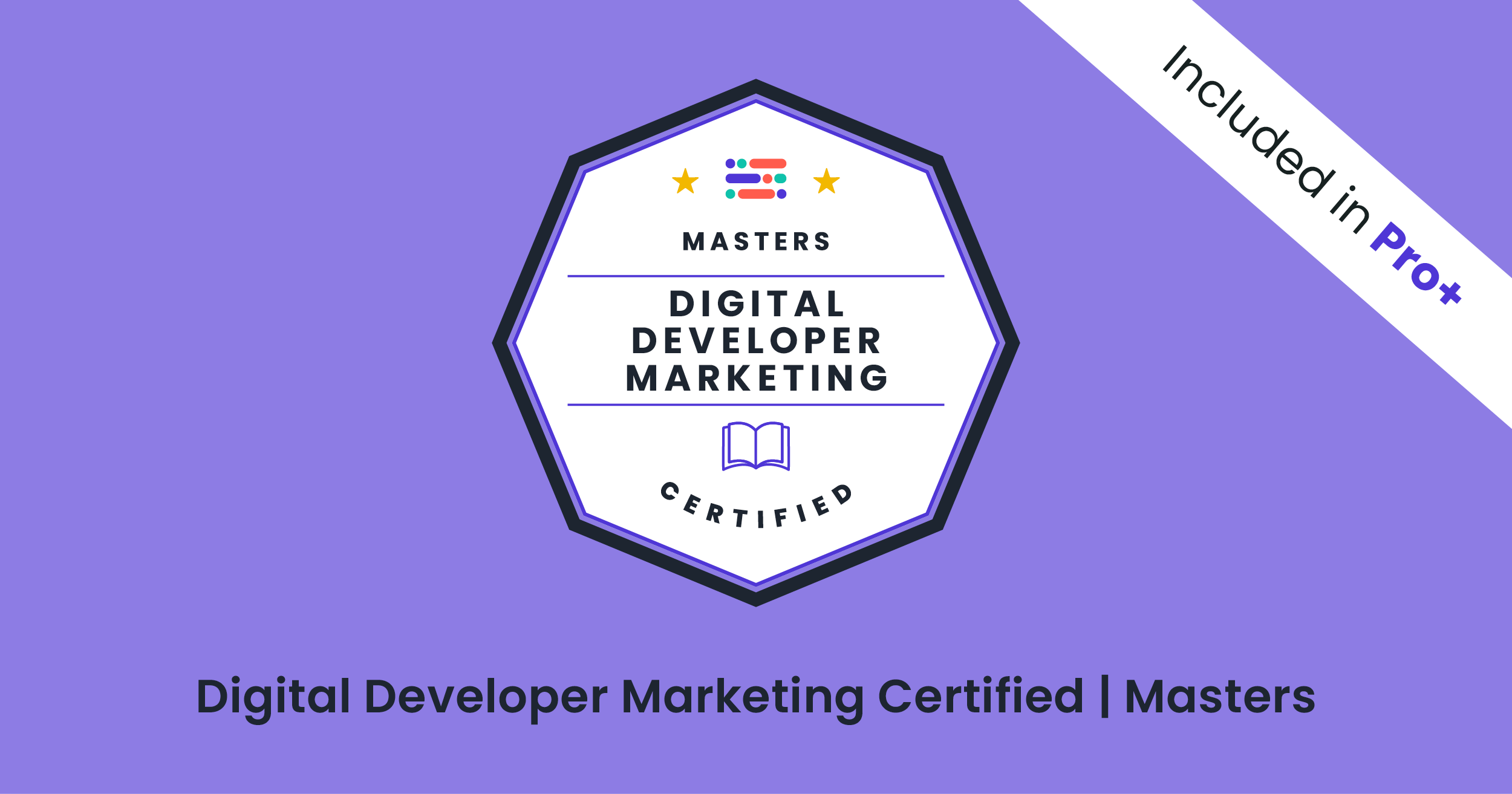Abhishek Ratna, Head of AI Product Marketing (ex-Google, Meta, Microsoft), has extensive expertise in developer personas, including how to garner their attention.
In our Digital Developer Marketing course, taught by Abhishek, you’ll get best practices to successfully run digital marketing to developers.
Sign up to get the full benefits of Abhishek’s insights and knowledge but, in the meantime, check out some of the course’s highlights below and learn more about targeting developer personas.
Why are developer personas and segments important? Developers tune out fluff and zoom in on relevant content. Relevance is key. To win mindshare, you need to understand and establish your developer personas.
The word developer can encompass many different people with different skills, motivations, and attitudes. For example, a data scientist cares less about the code and more about the learnings that his or her model brings to the business. Data scientists focus on running successful experiments to build great models with high accuracy.
This is very different from a data engineer who solves complex problems in sourcing, transforming, and piping data. Data engineers are tasked with ensuring high-quality, fresh, and relevant data for their businesses.
They care a lot more about technical detail, uptime, data quality, and operational metrics. By contrast, web developers focus on bringing the user experience to life, while making sure their apps and sites are highly performant.
This is just a small sample of the differences in personalities that you will encounter when working with developers. As you can see, each developer subgroup differs greatly from the others.
The complexity increases once you take into account other variables, like their experience levels. Are they new? Have they been working on this track for a while? What technologies do they use? And so on. A one-size-fits-all approach does not work for your developer marketing content.
Let’s look at a multi-phase approach to building developer personas.

Phases for creating developer personas
Phase 1
The internal audit. It all starts with an internal audit with your product teams, engineers, developer relations folks, and biz dev teams. These stakeholders deeply understand your end-user developers and the most important problems they’re facing, as well as the attitudes and nuances of the audiences you're trying to convince.
Phase 2
External research. After the audit is done and a straw man has been created, it's time to look at external research. This is where you will flesh out firmographic details and understand things like what tools your devs typically use and what their typical experience levels are.
You can be hacky and curate data from LinkedIn to build something quick and dirty, or you can go to the other extreme of sophistication and work with a specialized developer consulting firm like Stack Overflow or SlashData.
Phase 3
Voice of developer. Once you're done with the external audit, it's time to capture the voice of your developers. Look for feedback and comments from your target devs that articulate their pain points. Your product and engineering partners love quotes from developers as well as real feedback. By bringing these insights, you’ll be perceived as the voice of the customer and achieve more internal buy-in.
Phase 4
Segmentation model. Once you have completed the voice of the developer work, it's time to build your segments. Segmenting developers can be challenging due to their diverse backgrounds, skillsets, and interests.
However, by using a combination of demographic, behavioral, and psychographic segmentation, we can effectively target developer audiences.
Demographic segmentation: This includes factors like location, level of education, and job title. For example, you may target junior developers in a specific region or developers with a certain level of education.
Behavioral segmentation: This involves segmenting developers based on the use cases they work on, their tools of choice, communities they contribute to, nature of development, types of content they subscribe to, events they attend, etc.
Psychographic segmentation: This includes factors like attitudes, values, and motivations. Developers often code as a hobby on the side and learn continuously. So, you may target developers who are highly motivated by learning new technologies or who value open-source contributions. Hobbyists vs professionals is an example of this type of segmentation.
Firmographic segmentation: This would mean things like size of organization, developer’s job title, decision making authority within their organization and so on. The firmographic model allows you to separate the practitioners from the decision makers.

How to use CRM data to segment developers
That said, segmentation models must evolve from time to time. Technologies evolve fast. APIs that were cutting-edge just a couple of years ago can become obsolete, and the problems that developers are solving change very quickly over time.
Personally, I've found a combination of decision-making authority, professional titles and profiles, technologies they're working on, and goals or common use cases to be good ways of segmenting and targeting developers.
Now that we have an understanding of segmentation approaches, let's move on to creating segments based on your CRM data. Your CRM data is a valuable resource for creating developer segments.
Here are some tips for using your CRM data to segment developers effectively:
- Identify key attributes: Start by determining the most relevant attributes for your product and target audience. These may include programming languages, tools, platforms, or specific technologies. I have seen great results from using decision-making authority, job titles, programming tools to be a solid starting point.
- Analyze developer interactions: If possible, analyze how developers interact with your content, products, and services. Identify patterns and trends that can help you create powerful clusters based on content preferences.
- Create custom fields: Once you have established your segments, try creating custom fields in your CRM to store this information.
- Use tags and labels: Some attributes, like content engaged with, interaction with campaign, etc, are better stored using dynamic tags instead of static fields. This will allow you to create targeted marketing campaigns for each segment in a more automated way.
I will walk you through two common practical mechanisms for segmentation:
Segmentation via developer opt-in
Asking qualifying questions in sign-up forms is the most common technique developer marketers use for segmentation.
Typical questions may include:
- What use cases do you typically work on?
- Which of the following personas do you identify with?
- What is your decision making authority?
- What programming languages do you use?
- What tools, frameworks, and platforms do you work with?
- What is your level of experience with specific technologies?
- What are your primary motivations for using our product or service?
It's important to not create overbearing sign up forms as these would turn developers away. Instead you may adopt progressive profiling, where additional questions are surfaced upon subsequent form submissions. These questions will help you collect essential information about your target audience and create more targeted marketing campaigns.
Or, you can code segmentation rules into your CRM and Marketing database. While it may be a bit of up front work, your developers won't have to fill out as many fields. You can also bring in additional data from lead enrichment tools like zoom info and run your own custom rules. That will allow you to create even more powerful segments programmatically.
It’s important to note that setting up segments is a cross team effort, and will require you collaborating closely with a few other stakeholders, namely:
- Marketing Operations
- Campaign Teams
- Sales Ops
- Data Analysts
These teams often own the marketing systems and databases where segmentation data is stored, so you will need to collaborate and build a case for business value from segmentation at times.
Messaging to different segments
Once you have your segments, it's crucial to tailor your messaging to resonate with each segment. Here are some tips for tailoring your messaging:
- Focus on problems and use cases: Personalize your content by focusing on problems and topics your target segment cares about. For example, content like “best practices for data pipelines” (for data engineers) or “fine-tuning large language models” (for data scientists) will land well with your developer segments.
- Highlight relevant benefits: Focus on the benefits that are most relevant to each segment. Remember you are solving a problem, and the more accurate, clear and helpful your message is, the more you will win developer trust and admiration.
- Test and optimize: Continuously test your messaging and analyze the performance of your campaigns. Use this data to refine your messaging and improve your targeting.

How to measure success
To ensure the success of your targeting efforts, it's important to evaluate your strategies and make adjustments as needed. Here are some steps to follow:
- Monitor key performance indicators (KPIs): Track KPIs like open rates, click-through rates, and conversion rates to measure the effectiveness of your targeting efforts. We talk about these in modules 3,4 and 5.
- Conduct A/B tests: Test different messaging, content, and targeting strategies to determine what works best for each segment.
- Analyze campaign performance: Analyze the performance of your campaigns and identify areas for improvement. We will cover these in more detail in subsequent modules.
- Refine your approach: Based on your analysis, refine your targeting strategies to better resonate with your developer audience.
Want more?
Sign up to our Developer Digital Marketing course and learn from someone who’s worked at some of the world’s largest companies, including Google, Meta, and Microsoft.
With our course, you’ll:
🌎 Explore the unique needs and preferences of developers
👏 Gain buy-in from your key stakeholders
🪡 Learn how to tailor your campaign messaging and targeting to engage developers
🧑💻 Design impactful websites & perform SEO
📩 Create effective email marketing
📲 Engage developers with social media
📣 Build powerful developer-centric advertising campaigns
📈 Measure impact and extract powerful customer insights to refine campaigns
You’ll be better equipped to target developer audiences effectively and drive more meaningful results for your marketing efforts.






